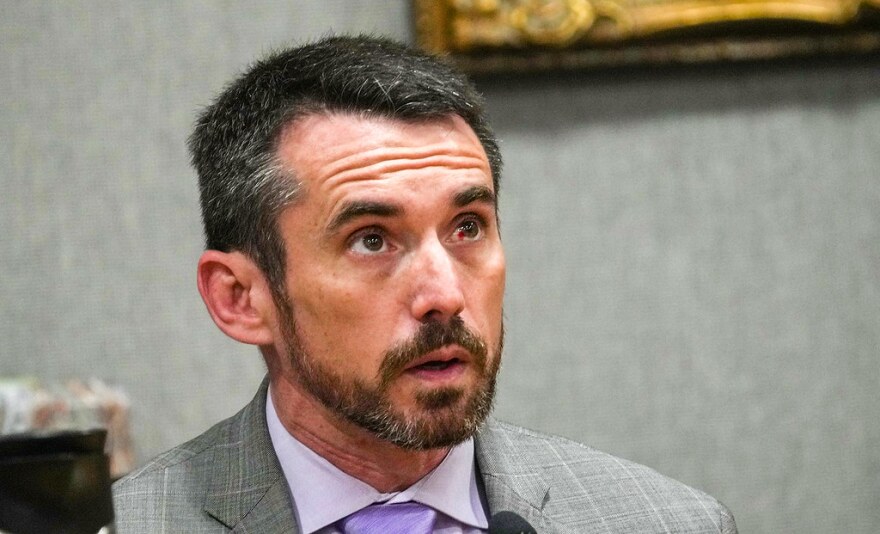Two weeks into the murder trial of Austin police officer Christopher Taylor, the prosecution has rested its case.
Now, the defense is trying to chisel away at their arguments that Taylor flouted best practices in policing and wrongly shot and killed Mike Ramos in April 2020.
Here's a rundown of what happened in the trial's second week and what to expect in the days ahead.
Preferential treatment argument
The trial began this week with the continued testimony of Dan Mireles, a former investigator for the Special Investigation Unit, which is tasked with investigating officer-involved shootings on behalf of the state.
Last week, prosecutors argued Taylor got preferential treatment by SIU because his uncle, Scott Askew, was Mireles' supervisor.

Askew was also Taylor’s peer-support officer, a position required by the department in the event of an officer-involved shooting, and was with Taylor the night of the shooting.
Prosecutors argued Mireles’ connection to Askew — and, indirectly, Taylor — adversely affected the initial investigation and led to then-District Attorney Margaret Moore’s decision to not prosecute.
Taylor's defense attorneys clapped back that the DA's office had access to the same information SIU did, that staff from the office's Civil Rights Unit were involved in the investigation, and that any deference given to Taylor was above board.
Prosecutors then called into question Taylor's statement to SIU saying Ramos' Prius was within “inches” of hitting another officer. The defense has consistently argued Taylor believed the car could've been used as a weapon and injured or killed officers responding to the call.
When questioned by prosecutors, Mireles said it was not fair to say "inches" and that he would've followed up with Taylor, but that interview never happened.
Drummond: Within your report, did you note the approximate distances ... from Officer Taylor to the car when Taylor fired his weapon?
Mireles: Yes.
Drummond: Was it approximately 18 or 19 feet ... according to your investigation?
Mireles: Those are approximate.
Drummond: Right. So, it was a matter of inches if you multiply 18 or 19 feet by 12 inches, right?
Mireles: Right.
Drummond: But that's not really what Officer Taylor is trying to convey in his statement, correct?
Mireles: His statement says inches.
Drummond: Would that be something you would want to ask him, as well?
Mireles: That would be a follow-up question.
Prosecutors argued Taylor’s statement was both inaccurate and provided without an interview, which "deviate[d] from the standard practice" of the police department, adding that officers were driven together to their interviews and had, possibly, the opportunity to talk about the incident.
Defense attorneys argued one of the prosecuting attorneys, Dexter Gilford, was involved in the process and that he had no problem with how things played out back in 2020.
Issues with evidence
Judge Dayna Blazey scolded prosecutors for not previously disclosing evidence from one expert witness on the damage caused by each bullet fired at Ramos.
“I can't believe that you're providing [an] expert document, expert demonstrative evidence after the trial begins,” she said. “This [case] is three years old.”
Wilson Hayes, an expert in biomechanics, was allowed to testify, but had to demonstrate the path of the bullets on one of the prosecutors and a poster-board diagram.

Prosecutors have argued Taylor shot Ramos when he was fleeing police and presented no threat.
On Tuesday, the prosecution called a key expert witness in the George Floyd case, Seth Stoughton. Stoughton is a former police officer, law school professor and use-of-force expert.

Taylor’s attorneys argued Stoughton’s testimony could prejudice jurors against their client, as he'd been involved in a high-profile murder case against a police officer. That argument failed, but they later had a chance to cross-examine Stoughton on Wednesday.
Stoughton told prosecutors that based on the evidence he believed Ramos posed no threat to Taylor or other responding officers.
“In this case, Mr. Ramos presented a threat of escape, but not a threat of serious bodily injury or death," he testified. "So, the use of deadly force in response was not proportional or consistent with generally accepted police practices.”
Defense attorney Ken Ervin argued that while Stoughton may be an expert on use-of-force, he wasn't an expert on Texas law, specifically murder.
"You're not offering an opinion whether his actions were legal under Texas law?" Ervin asked, to which Stoughton said no.
Defense's opening arguments
On Wednesday, the defense got its chance to make a case to jurors. Attorney Doug O'Connell led off, arguing Taylor made a split-second decision, that he and other officers took "initiative" in responding to the call. He said they staged a "reasonable plan" to approach Ramos.
"That’s exactly what we, the community, expect from our police officers," O'Connell said.
O'Connell also highlighted the possibility that Ramos was armed and that he was driving a stolen vehicle.
“Michael Ramos, driving a stolen car, with stolen license plates, didn’t want to go to jail," he said.

O'Connell also promised to show jurors a 3D recreation of the scene, along with unseen dashcam and bodycam footage.
"You'll hear our answers ... to questions that haven't been asked yet," he said. "And when you hear those answers, we want you to wonder why we had to ask the question."
On Thursday, the defense questioned responding officers about their response time, the uncertainty about whether Ramos had a gun and their involvement with the investigation.
So far, Ben Hart, who planned the officers' response to the Ramos call, and Darrell Cantu-Harkless, the officer nearest to Ramos' when he attempted to flee, have testified.
Mitchell Pieper, who shot Ramos with the less-lethal beanbag round, testified Friday, along with his training officer, James Morgan.
Two other officers who responded to the scene, Valerie Tavarez and Katrina Ratcliff, also took the stand.
Ratcliff described the Prius Ramos was driving as an "unguided missile" and said she believed she and Officer Cantu-Harkless were "in the only viable path" out of the apartment complex.
Defense and prosecutors also pored over previously unseen bodycam footage of Ratcliff, an Army veteran, performing first aid on Ramos. The footage shows her washing blood off her hands and talking with EMS personnel.
"Nobody was hurt," she told them.
Prosecutor Josh Smalley asked if that included Ramos, adding that she "saw his brain exposed after he was shot by the defendant."
Smalley: The next thing that you said was that, ‘Everybody’s OK.’ Was Michael Ramos OK?
Ratcliff: No.
Smalley: And he’s a person, too, right?
Ratcliff: Correct.
Smalley also questioned Ratliff about her resignation from the department in November 2020.
"Due to the political climate that was going on with Austin City Council and the Travis County District Attorney's office I did not feel like it was a suitable career for my wife and I to be subjected to," she said.
Smalley pressed Ratcliff on a social media post she made after resigning in which she said, "[Police] should not all be defined by the poor choices made by bad officers." Ratliff said the post wasn't in reference to a specific case.
"Is this case one of them?" Smalley asked.
"No," she said.
Taylor's defense attorneys are expected to call two expert witnesses next week. Closing arguments could come as soon as Tuesday.













